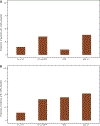Early Changes in Cardiovascular Biomarkers with Contemporary Thoracic Radiation Therapy for Breast Cancer, Lung Cancer, and Lymphoma
- PMID: 30445173
- PMCID: PMC6722323
- DOI: 10.1016/j.ijrobp.2018.11.013
Early Changes in Cardiovascular Biomarkers with Contemporary Thoracic Radiation Therapy for Breast Cancer, Lung Cancer, and Lymphoma
Abstract
Purpose: We characterized the early changes in cardiovascular biomarkers with contemporary thoracic radiation therapy (RT) and evaluated their associations with radiation dose-volume metrics including mean heart dose (MHD), V5, and V30.
Methods and materials: In a prospective longitudinal study of 87 patients with breast cancer, lung cancer, or mediastinal lymphoma treated with photon or proton thoracic RT, blood samples were obtained pre-RT and after completion of RT (median, 20 days; interquartile range [IQR], 1-35). High-sensitivity cardiac troponin T, N-terminal pro-B-type natriuretic peptide, placental growth factor (PIGF), and growth differentiation factor 15 (GDF-15) were measured. Associations between MHD, V5 and V30, and biomarker levels and associations between echocardiography-derived measures of cardiac function and biomarker levels were assessed in multivariable linear regression models. Analyses were performed according to the following subgroups: (1) breast cancer alone and (2) lung cancer and lymphoma combined.
Results: The median (IQR) estimates of MHD ranged from 1.3 Gy (0.9-2.4) in breast cancer (n = 60) to 6.8 Gy (5.4-10.2) in mediastinal lymphoma (n = 14) and 8.4 Gy (6.7-16.1) in lung cancer (n = 13) patients (P < .001). There were no significant increases in biomarker levels from pre-RT to post-RT in breast cancer. In lung cancer/lymphoma, PIGF increased from a median (IQR) of 20 ng/L (16-26) to 22 ng/L (16-30) (P = .005), and GDF-15 increased from 1171 ng/L (755-2493) to 1887 ng/L (903-3763) (P = .006). MHD, V5, and V30 were significantly associated with post-RT PIGF and GDF-15 levels in multivariable models. Changes in biomarkers were not significantly associated with changes in echocardiography-derived measures of cardiac function.
Conclusion: Contemporary thoracic RT induces acute abnormalities in vascular and inflammatory biomarkers that are associated with radiation dose-volume metrics, particularly in lung cancer and mediastinal lymphoma. Long-term follow-up studies are needed to determine the impact of these changes on the development of overt cardiac disease.
Copyright © 2018. Published by Elsevier Inc.
Conflict of interest statement
Conflict of interest: none.
Figures


Comment in
-
Radiation and cardiovascular disease.Ann Transl Med. 2019 Dec;7(Suppl 8):S371. doi: 10.21037/atm.2019.08.107. Ann Transl Med. 2019. PMID: 32016089 Free PMC article. No abstract available.
References
-
- Darby SC, Ewertz M, McGale P, et al. Risk of ischemic heart disease in women after radiotherapy for breast cancer. N Engl J Med 2013; 368:987–998. - PubMed
-
- Jaworski C, Mariani JA, Wheeler G, Kaye DM. Cardiac complications of thoracic irradiation. J Am Coll Cardiol 2013;61:2319–2328. - PubMed
-
- Filopei J, Frishman W. Radiation-induced heart disease. Cardiol Rev 2012;20:184–188. - PubMed
Publication types
MeSH terms
Substances
Grants and funding
LinkOut - more resources
Full Text Sources
Medical
Research Materials
Miscellaneous

